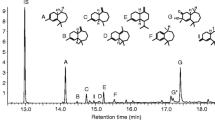Summary.
Both male and female Holotrichia loochooana loochooana (Sawada) (Coleoptera: Scarabaeidae) were attracted with female-produced pheromone, anthranilic acid (2-aminobenzoic acid), in the field. Male chafers were observed to apparently directly locate cotton balls impregnated with 1 to 10 mg of pheromone. In contrast, females never directly oriented to the treated balls but landed 0.2-1.5 m away and exposed their abdominal glands in a calling posture, which occasionally resulted in aggregation of both females and males. This suggested the mating aggregation of this species could be primarily induced by pheromone released by females. A hypothesis for adaptability of female aggregation is proposed and discussed.
Similar content being viewed by others
Author information
Authors and Affiliations
Corresponding author
Rights and permissions
About this article
Cite this article
Arakaki, N., Wakamura, S., Yasui, H. et al. Sexually differentiated functions of female-produced pheromone of the black chafer Holotrichia loochooana loochooana (Sawada) (Coleoptera: Scarabaeidae). Chemoecology 13, 183–186 (2003). https://doi.org/10.1007/s00049-003-0247-z
Accepted:
Issue Date:
DOI: https://doi.org/10.1007/s00049-003-0247-z




